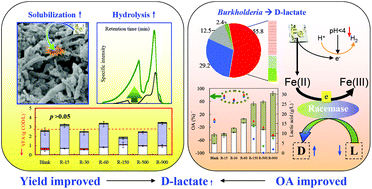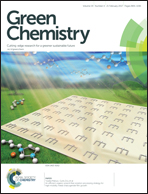Enrichment of d-lactic acid from organic wastes catalyzed by zero-valent iron: an approach for sustainable lactate isomerization†
Abstract
Recently, food waste and waste activated sludge (WAS) have been bio-valorized to lactic acid, an important industrial intermediate and widely used precursor for biodegradable plastic. Although optically pure L-lactic acid could be efficiently fermented previously, the bio-conversion of D-lactic acid with high optical activity is still difficult. In this study, we introduce a green approach catalyzed by zero-valent iron (ZVI), in which a high yield of optical activity (81%) of D-lactic acid (6.4-fold versus the Blank) was successfully obtained from organic wastes. On studying the mechanism, it was revealed that the enhancement of lactic acid yield was because of the acceleration of solubilization and hydrolysis in the presence of ZVI. In addition, proper dosage of ZVI (60 mg g−1 TSS) was beneficial for the proliferation of Burkholderia, which overwhelmingly produced D-lactic acid under facultative conditions. Moreover, electron transfer during Fe(II)→Fe(III) was thermodynamically favorable when adding ZVI, and, during this process, the isomerization of L-lactate → D-lactate was observed simultaneously. Finally, a bioelectrochemical system with two electrodes was employed instead of adding ZVI to disclose the catalytic role of electron transfer on the high OA of D-lactic acid generation. This finding provides an efficient way for the sustainable enrichment of D-lactic acid, from waste streams, with high optical activity.

- This article is part of the themed collection: 2017 Green Chemistry Hot Articles

 Please wait while we load your content...
Please wait while we load your content...